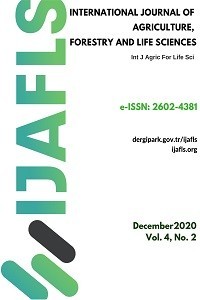Determination of the yield performance and partial seed vernalization response of wheat varieties in late spring sowing
Determination of the yield performance and partial seed vernalization response of wheat varieties in late spring sowing
Late sowing, , seed vernalization, spring sowing,
___
- Altay, F. (2012). Yield stability of some Turkish winter wheat (Triticum aestivum L.) genotypes in the western transitional zone of Turkey. Turkish J. of Field Crops. 17(2): 129-134.
- Anderson, W.K. and Smith, W.R. (1990). Yield advantage of twosemi-dwarf compared with two tall wheats depends onsowing time. Australian Journal of Agricultural Research. 41:811-826.
- Asseng, S., Martre, P., Maiorano, A., Rötter, R.P., O’Leary, G.J., Fitzgerald, G.J. ... and Reynolds, M.P. (2019). Climate change impact and adaptation for wheat protein. Global Change Biology. 25(1):155-173.
- Chouard, P. (1960). Vernalization and its relations to dormancy. Annu. Rev. Plant Physiol. 11:191-238.
- Doorenbos, J. and Kassam, A.H. (1979). Yield response to water. FAO Irrigation and drainage paper, 33:257.
- Evans, L.T., Wardlaw, I.F. and Fischer, R.A. (1975). Wheat. In: Crop Physiology: Some Case Histories, ed. Evans, L.T., 101-149.Cambridge University Press, London, UK.
- Ferrisea, R., Triossi, A., Stratonovitch, P., Bindi M. and Martre, P. (2010). Sowing date and nitrogen fertilisation effects on dry matter and nitrogen dynamics for durum wheat: An experimental and simulation study. Field Crops Research. 117(2-3):245-257.
- FIood, R.G. and Halloran, G.M. (1984). Basic development rate in spring wheat. Agron. J. 76:260-264.
- Galiba, G., Quarrie, S.A., Sutka, J., Morgounov, A. and Snape, J.W. (1995). RFLP mapping of the vernalization (Vrn1) and frost resistance (Fr1) genes on chromosome 5A of wheat. Theoretical and Applied Genetics. 90(7-8):1174-1179.
- Li, G., Boontung, R., Powers, C., Belamkar, V., Huang, T., Miao, F., ... and Yan, L. (2017). Genetic basis of the very short life cycle of ‘Apogee’ wheat. BMC genomics, 18(1):838.
- Li, Q.Y., Jun, Y.I.N., Liu, W.D., Zhou, S.M., Lei, L.I., Niu, J.S., ... and Ying, M.A. (2012). Determination of optimum growing degree-days (GDD) range before winter for wheat cultivars with different growth characteristics in North China Plain. Journal of Integrative Agriculture. 11(3):405-415.
- MGM, (2019). Turkish State Meteorological Service. https://www.mgm.gov.tr. (Accessed January 15, 2019)
- Nyachiro, J.M., Clarke, F.R., DePauw, R.M., Knox, R.E. and Armstrong, K.C. (2002). Temperature effects on seed germination and expression of seed dormancy in wheat. Euphytica. 126(1):123-127.
- Ortiz Ferrara, G., Mosaad, M.G., Mahalakshmi, V. and Fischer, R.A. (1995). Photoperiod and vernalization response of wheat under controlled environment and field conditions. Plant Breeding. 114(6):505-509.
- Panozzo, J.F. and Eagles, H.A. (1999). Rate and duration of grain filling and grain nitrogen accumulation of wheat cultivars grown in different environments. Australian Journal of Agricultural Research. 50:1007-1015.
- Perry, M., and Belford, R.K. (1991). Environmental control of plant development. In: The Wheat Book. A Technical Manual for Wheat Producers ed. Perry M. and Hillman B. Department of Agriculture, Bulletin 4196,35-36. Australian Wheat Board, Western Australia.
- Ritchie, J.T. (1991). Wheat phasic development. In: Modeling Plant and Soil Systems, ed. Hanks R.J. and Ritchie, J.T. Agronomy Monograph 31, American Society of Agronomy, Madison, Wisconsin, USA.
- Schmütz, W. (1976). Neuere Ergebnisse zur Beziehung zwischen Vcrnalisations bedarf und wintergestigkeit bei getreide, Verlag und Durck der Bundesversuchsaostalt für alpenladische Landwirtschaft Gupenstein Landessaatzuchtanstalt der Universität Hohenheim Garbenstrasse 9, D-7000 Stutgart 70:77-86.
- Subedi, K.D., Ma, B.L. and Xue, A.G. (2007). Planting date and nitrogen effects on grain yield and protein content of spring wheat. Crop Science. 47(1):36-44.
- Sutka, J. (2001). Genes for frost resistance in wheat. Euphytica. 119(1-2):169-177.
- Tas, B. and Celik, N. (2008). Determination of vernalization responses in some winter wheat varieties grown in temperate regions. Asian Journal of Plant Sciences. 7(6):607-610.
- Watson, A., Ghosh, S., Williams, M.J., Cuddy, W.S., Simmonds, J., Rey, M.D., ... and Adamski, N.M. (2018). Speed breeding is a powerful tool to accelerate crop research and breeding. Nature Plants. 4:23-29.
- Weir, A.H., Bragg, P.L., Porter J.R. and Rayner, J.H. (1984). A winter wheat crop simulation model without water or nutrient limitations. The Journal of Agricultural Science. 102(2):371-382.
- Wort, D.J. (1939). Vernalization of marquis wheat and other spring cereals. Botanical Gazette. 101(2):457-481.
- Wu, X., Liu, H., Li, X., Tian Y. and Mahecha, M.D. (2017). Responses of winter wheat yields to warming-mediated vernalization variations across temperate Europe. Frontiers in Ecology and Evolution. 5:126.
- Yasuda, S. and Shimoyama, H.(1965). Analysis of internal factors influencing the heading time of wheat varieties. Ber. Ohara Inst. landw. Biol. Okayama U. 13(1): 23–38
- Yayın Aralığı: Yılda 2 Sayı
- Başlangıç: 2017
- Yayıncı: Volkan OKATAN
Hridesh SHARMA, Sandeep CHAPAGAİN, Sudeep MARASİNİ
Nurhan KESKİN, Siyami KARACA, Faruk ALAEDDİNOĞLU, Sıddık KESKİN, Adnan DOĞAN, Cuneyt UYAK, Ruhan İlknur GAZİOGLU ŞENSOY, Bulut SARGIN, Birhan KUNTER
Fitri RACHMAWATİ, Dewi PRAMANİK, Budi WİNARTO
Riza TEMİZKAN, Muhammed Ali DOĞAN, Orhan ATAKAN, Burak Alptuğ NAZLIM, Hüseyin AYVAZ
Essential oil content and composition of Cotinus coggygria Scop. from Hatay, Turkey
Kerem MERTOĞLU, Aysel GÜLBANDILAR, İbrahim BULDUK
Recent developments of industrıal enzyme production in food biotechnology
